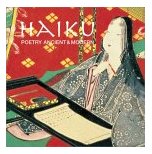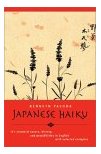|
Contents » Cover |
||
|
Reviews
Microsoft haiku, Spamku, a periodic table of science fiction haiku, not to mention 680,997 other hits—if a Google search measures what the literate, Internet Age public is aware of, haiku appears to be known to just about everyone. And it is, in one form or another. Haiku is taught to children as a way to introduce poetry in bite-sized portions. It has intrigued Western poets for a century, from Pound through the Beats to today. Jack Kerouac and Gary Snyder, thinly veiled as characters in Dharma Bums, spout haiku in fits of enlightenment as they bound up a mountain. How much do these manifestations have in common with the 300-year-old Japanese poetic form? In the case of the internet haiku phenomenon, absolutely nothing, of course. But Western poets have long understood real aspects of how haiku work, and their universal poetic value. In the 1950s, a serious English-language haiku movement was born. Instructed by the writings of haiku scholars like R. H. Blyth—whose four-volume study Haiku and two-volume A History of Haiku remain essential reading for serious haiku poets—and Harold G. Henderson, a handful of poets began to create in the form in English. The two books reviewed here show, in different ways, how far English-language haiku has come in the intervening fifty years. Haiku: Poetry Ancient and Modern is an anthology of over 250 haiku, beautifully illustrated with full-color woodblock prints and details from Japanese fabrics. The haiku are a mix of Japanese classics (translated) and contemporary poems in English, often on the same page. This is rare in haiku publishing—there are many anthologies of Japanese haiku and an increasing number of English-language haiku books, but this is the first collection I've seen which doesn't separate them in any way. It's enriching for both the classic and the modern poems. The older poems feel more relevant, and the contemporary poems are illuminated by the tradition to which they belong. In some instances, the modern poems allude directly to the classic haiku they appear beside:
in the icy moonlight
Another book published by Tuttle—Kenneth Yasuda's The Japanese Haiku: Its Essential Nature, History, and Possibilities in English—appeared in 1957, and has been reprinted thirteen times. It remains one of the most readily available books on haiku in English, but that popularity is surprising. Originally Yasuda's doctoral dissertation, it is dry reading compared to Blyth's flamboyantly opinionated books, and his translations are archaic. Yasuda follows the traditional 5-7-5 syllable structure, no matter how awkward it becomes in English, and even adds end-rhyme. Compare his translation of a classic haiku by Basho with the one that appears in Haiku: Poetry Ancient and Modern:
How silent and still! The 5-7-5 structure isn't inherently archaic—it's still a hotly debated topic. Rhyme, however, has never been a popular option. But while I wouldn't recommend Yasuda's book as an introduction to haiku, it is excellent for poets who have worked in the form and thought deeply about it. His grasp of haiku history and theory is unrivalled, even if his practice seems old-fashioned now. He covers many of the issues still facing the English-language haiku poet exhaustively, from syllable count to the use of season-words. He analyzes haiku as poetic gems that suggest more than they say and invite the reader to enter into the moment of inspiration. And he understands haiku as a spiritual practice that cultivates the essential oneness of the ego with the world. Or, as a poem from the anthology puts it:
morning sneeze
|
||||||||

